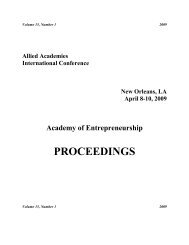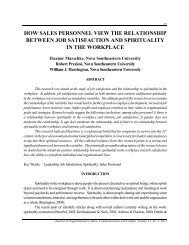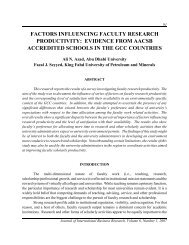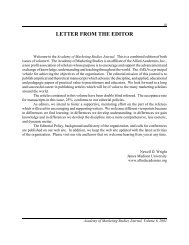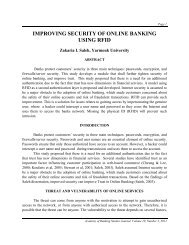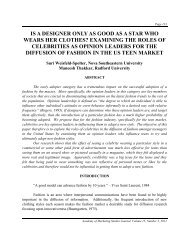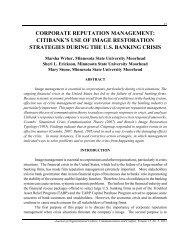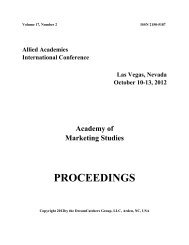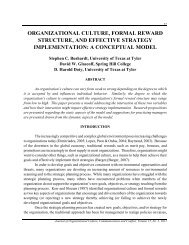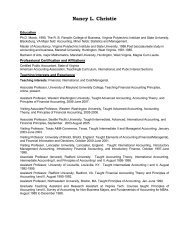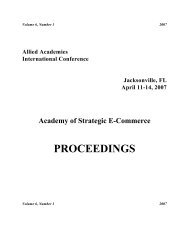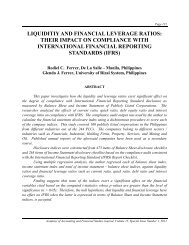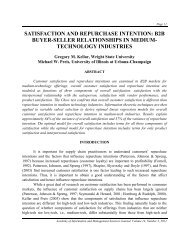F:\AAFSJ\AAFSJ Vol 14 No 2 2010.wpd - Allied Academies
F:\AAFSJ\AAFSJ Vol 14 No 2 2010.wpd - Allied Academies
F:\AAFSJ\AAFSJ Vol 14 No 2 2010.wpd - Allied Academies
Create successful ePaper yourself
Turn your PDF publications into a flip-book with our unique Google optimized e-Paper software.
2. Eigenschaften3. Sterilisierung und Lebensmittelsicherheit■ Gute chemische Beständigkeit■ Hohe Schmutzaufnahmekapazität■ Absolute Abscheideraten (ß-Ratio ≥ 5000)■ Eingesetztes Material chemisch und biologisch inert gemäß FDAund EG Richtlinien■ Dampfsterilisierbar im eingebauten Zustand■ Sanitisierung mit heißem WasserSterilisierung / SanitisierungSterilisierung mit Dampf 50 Stunden kumulativ bei 125 °C und einerZykluszeit von 30 Minuten. Heißwasser-Sanitisierung mit max.80 °C Wasser.LebensmittelsicherheitDie Filterkerzen erfüllen die Europäische Richtlinie 2002/72/EG fürden Kontakt mit Lebensmitteln und globale Migration. Alle eingesetztenMaterialien sind in den FDA 21CFR Regularien gelistet.4. Technische Daten5. Wasser-Durchflussrate für eine 10“ FilterkerzeFiltermedium: PolypropylenKomponenten: PolypropylenEnd-Dichtungen: thermisch verschweißtDichtungen / O-Ringe: Silikon, EPDM, Viton®,Polyethylen (nur für X9)andere Materialien auf AnfrageAbmessungenAußendurchmesser: 68 mmLänge: siehe BestellkodierungFiltrationsfläche: 0,05 m²/10” KerzemmEmpfohlener maximaler DifferenzdruckEntwurf : 5,0 bar bei 25 °CBetrieb : 2,0 bar bei 25 °CMaximale Betriebstemperatur : 80 °Cx: Durchflussratey: Anfangs-Differenzdruck6. BestellkodierungBeispielamaPure TS 1 10 U X7 EKerzen Typ Feinheit0.30.513Länge nominal [Zoll]10 (254 mm)20 (508 mm)30 (762 mm)40 (1016 mm)HardwareU=PolypropylenKern und AußenkäfigAußenkäfig nichtAusführungenX3X4X7X8MaterialDichtungen / O-RingeS=SilikonE=EPDMV=Viton®51015203040507090Andere Längen auf Anfrageverfügbar fürX9 AusführungX9X3=SOE mit außenliegenden O-Ringen Typ 222, X4=DOE mit Flachdichtungen, X7=SOE mit Zentrierspitze, Bajonett und außenliegenden O-Ringen Typ 226, X8=SOE mit Zentrierspitze und außenliegenden O-Ringen Typ 222, X9=DOE mit Polyethylen-DichtungenMAHLE Filtersysteme GmbH Industriefiltration, Schleifbachweg 45, D-74613 Öhringen, Phone +49 (0) 7941/67-0 Fax +49 (0) 7941/67-23429,industriefiltration@mahle.com, http://www.mahle-industrialfiltration.com, 10/2009Filterkerzen amaPure TS 2
113LIMITATION OF THE STUDYThere were two limitations in the study: (1) Missing cases--a number of cases in this studyhad missing variables and were removed from the study as reported in the three scenarios; (2) Theexternal validity of the model was not tested.CONCLUSIONSThe research output of the study was robust and showed that beta’s power was insignificantin predicting stock price movements. It raised a serious question about using it as a measure of riskwhen it indeed unreliable. On the other hand, the price-earnings ratio exhibited significant powerin predicting stock price movements and accordingly was a more reliable measure of risk.This study poses a real dilemma that we need to address imminently. Should beta’s role asthe dominant measure of risk be continued? We recommend further research to test the externalvalidity of this model by applying it to other stock markets and or different time frames.BIBLIOGRAPHYAng, Andrew, G. Bekaert (2003), “Stock Return Predictability: Is it There?”. Columbia University and NBER, July 2003.Aras and Yilmaz (2008) Price-earnings Ratio, Dividend Yield, and Market-to-book Ratio to Predict Return on StockMarket: Evidence from the Emerging Markets. Journal of Global Business and Technology, 4(1), Spring 2008.Baigent, G Glenn, and Vincent G Massaro (2005). “Derivatives and the 1987 Market Crash” Management ResearchNews Patrington, 28(1), 94-105.Fama, E.F., K.R. French (1992), “The Cross-Section of Expected Stock Returns”, Journal of Finance, 47, 427-465.Lamont, O. (1998), “Earnings and Expected Returns”, Journal of Finance, 53, 1563-1587.Lewellen, J. (2002), “Predicting Returns with Financial Ratios”, Journal of Financial Economics, 1-38.<strong>No</strong>fsinger, John (2001). “Psychology and Investing”; http://www.phptr.com / articles /article.asp?p=21917.Ofek, E. and M. Richardson (2003), 'Dot.Com mania: the rise and fall of internet prices,' Journal of Finance, 58, 1113-1138.Olujide, J. (2000). Exposure to Financial Ratio Analysis of Three Operating Firms in the Beer Industry in Nigeria.Journal of Financial Management & Analysis, 13, 69-73.Sornette, D. (2003). A Complex System View of Why Stock Markets Crash. www.goldeagle.com/editorials_03/sornette071603pv.tml.Academy of Accounting and Financial Studies Journal, <strong>Vol</strong>ume <strong>14</strong>, Number 2, 2010
1<strong>14</strong>Tsun-Siou, Lee, Yin-Hua, Yeh and Rong-Tze, Liu (2003). “Can Corporate Governance Variables Enhance the PredictionPower of Accounting-Based Financial Distress Prediction Models?”;http://cei.ier.hit-u.ac.jp/working/2003/2003WorkingPapers/wp2003-<strong>14</strong>.pdf.Zuckerman E, Rao H. (2004). Shrewd, crude or simply deluded? Co-movement and the internet stock phenomenon.Industrial and Corporate Change. Oxford.13(1), 171.Academy of Accounting and Financial Studies Journal, <strong>Vol</strong>ume <strong>14</strong>, Number 2, 2010



